The Effects of Racism and Stereotyping on Aboriginal Student Education
VerifiedAdded on 2022/07/28
|7
|1497
|24
Essay
AI Summary
This essay critically examines the detrimental effects of racism and stereotyping on Aboriginal students' educational outcomes within the Australian school system. It delves into the ways in which discrimination manifests in classrooms and schools, highlighting the various forms of prejudice experienced by Aboriginal students, including verbal abuse, exclusion, and unfair treatment. The essay then analyzes the significant impact of these experiences on student outcomes, such as lower academic achievement, increased absenteeism, and psychological distress. Furthermore, the essay explores the decision of students to change schools or drop out, and the impact on their identity and sense of belonging. The paper also discusses the link between the economic and social disadvantages, and the health of the students. Finally, the essay proposes and discusses strategies that teachers can implement to foster a more inclusive and equitable classroom environment. These strategies involve promoting cultural understanding, challenging stereotypes, and creating a safe and supportive learning space for all students. The essay draws on relevant literature and policies to support its arguments and offers practical recommendations for educators to address racism and stereotyping in schools effectively.
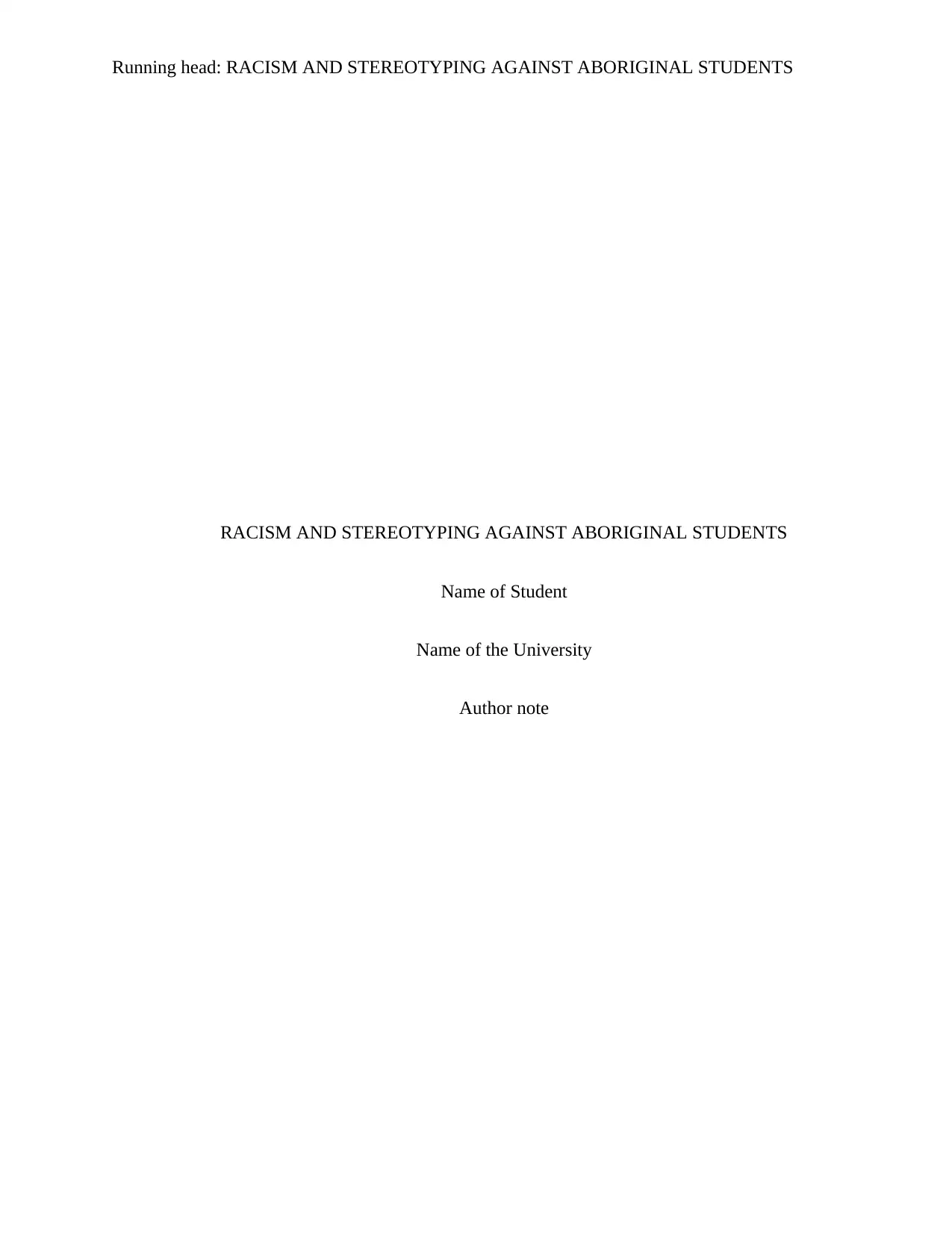
Running head: RACISM AND STEREOTYPING AGAINST ABORIGINAL STUDENTS
RACISM AND STEREOTYPING AGAINST ABORIGINAL STUDENTS
Name of Student
Name of the University
Author note
RACISM AND STEREOTYPING AGAINST ABORIGINAL STUDENTS
Name of Student
Name of the University
Author note
Paraphrase This Document
Need a fresh take? Get an instant paraphrase of this document with our AI Paraphraser
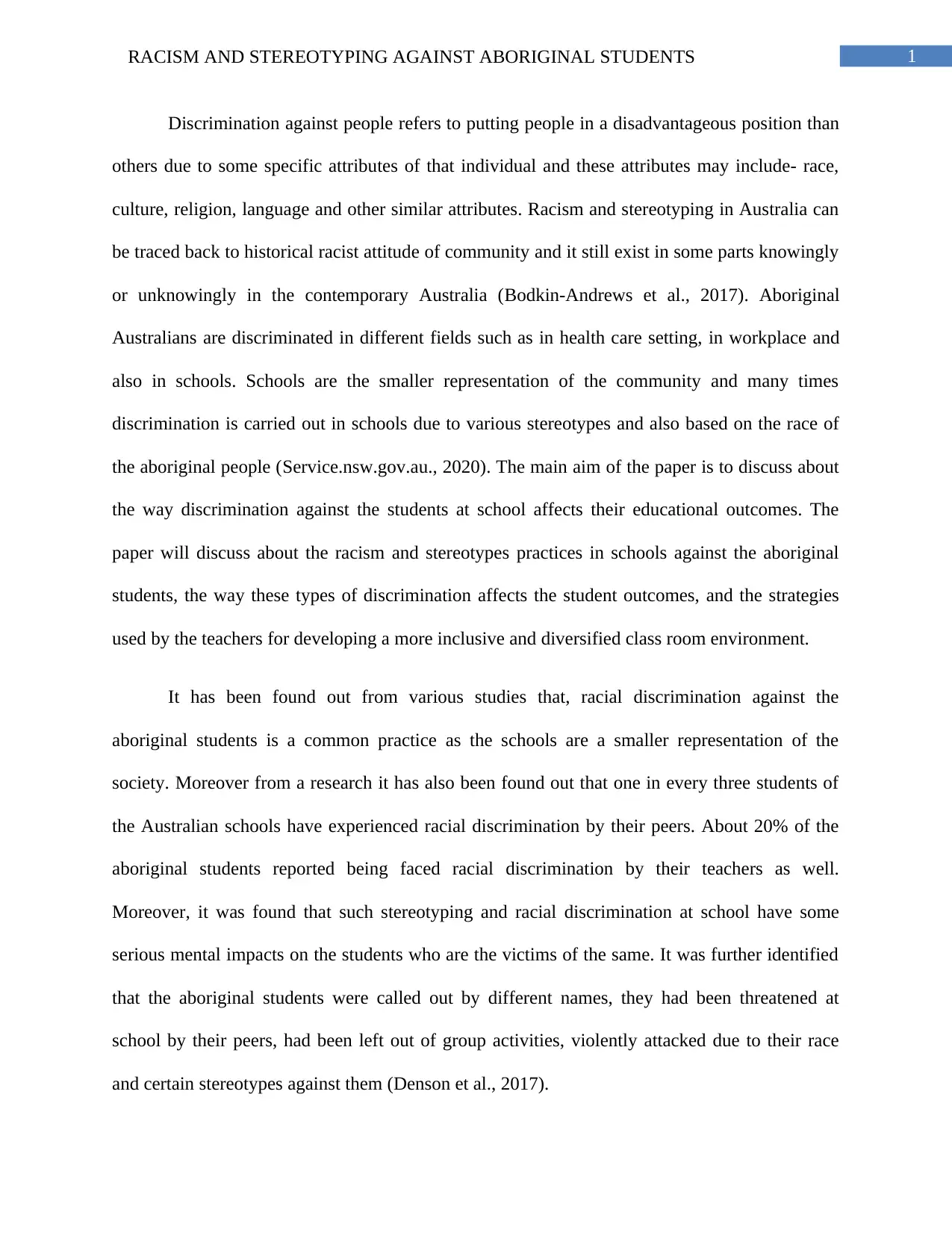
1RACISM AND STEREOTYPING AGAINST ABORIGINAL STUDENTS
Discrimination against people refers to putting people in a disadvantageous position than
others due to some specific attributes of that individual and these attributes may include- race,
culture, religion, language and other similar attributes. Racism and stereotyping in Australia can
be traced back to historical racist attitude of community and it still exist in some parts knowingly
or unknowingly in the contemporary Australia (Bodkin-Andrews et al., 2017). Aboriginal
Australians are discriminated in different fields such as in health care setting, in workplace and
also in schools. Schools are the smaller representation of the community and many times
discrimination is carried out in schools due to various stereotypes and also based on the race of
the aboriginal people (Service.nsw.gov.au., 2020). The main aim of the paper is to discuss about
the way discrimination against the students at school affects their educational outcomes. The
paper will discuss about the racism and stereotypes practices in schools against the aboriginal
students, the way these types of discrimination affects the student outcomes, and the strategies
used by the teachers for developing a more inclusive and diversified class room environment.
It has been found out from various studies that, racial discrimination against the
aboriginal students is a common practice as the schools are a smaller representation of the
society. Moreover from a research it has also been found out that one in every three students of
the Australian schools have experienced racial discrimination by their peers. About 20% of the
aboriginal students reported being faced racial discrimination by their teachers as well.
Moreover, it was found that such stereotyping and racial discrimination at school have some
serious mental impacts on the students who are the victims of the same. It was further identified
that the aboriginal students were called out by different names, they had been threatened at
school by their peers, had been left out of group activities, violently attacked due to their race
and certain stereotypes against them (Denson et al., 2017).
Discrimination against people refers to putting people in a disadvantageous position than
others due to some specific attributes of that individual and these attributes may include- race,
culture, religion, language and other similar attributes. Racism and stereotyping in Australia can
be traced back to historical racist attitude of community and it still exist in some parts knowingly
or unknowingly in the contemporary Australia (Bodkin-Andrews et al., 2017). Aboriginal
Australians are discriminated in different fields such as in health care setting, in workplace and
also in schools. Schools are the smaller representation of the community and many times
discrimination is carried out in schools due to various stereotypes and also based on the race of
the aboriginal people (Service.nsw.gov.au., 2020). The main aim of the paper is to discuss about
the way discrimination against the students at school affects their educational outcomes. The
paper will discuss about the racism and stereotypes practices in schools against the aboriginal
students, the way these types of discrimination affects the student outcomes, and the strategies
used by the teachers for developing a more inclusive and diversified class room environment.
It has been found out from various studies that, racial discrimination against the
aboriginal students is a common practice as the schools are a smaller representation of the
society. Moreover from a research it has also been found out that one in every three students of
the Australian schools have experienced racial discrimination by their peers. About 20% of the
aboriginal students reported being faced racial discrimination by their teachers as well.
Moreover, it was found that such stereotyping and racial discrimination at school have some
serious mental impacts on the students who are the victims of the same. It was further identified
that the aboriginal students were called out by different names, they had been threatened at
school by their peers, had been left out of group activities, violently attacked due to their race
and certain stereotypes against them (Denson et al., 2017).
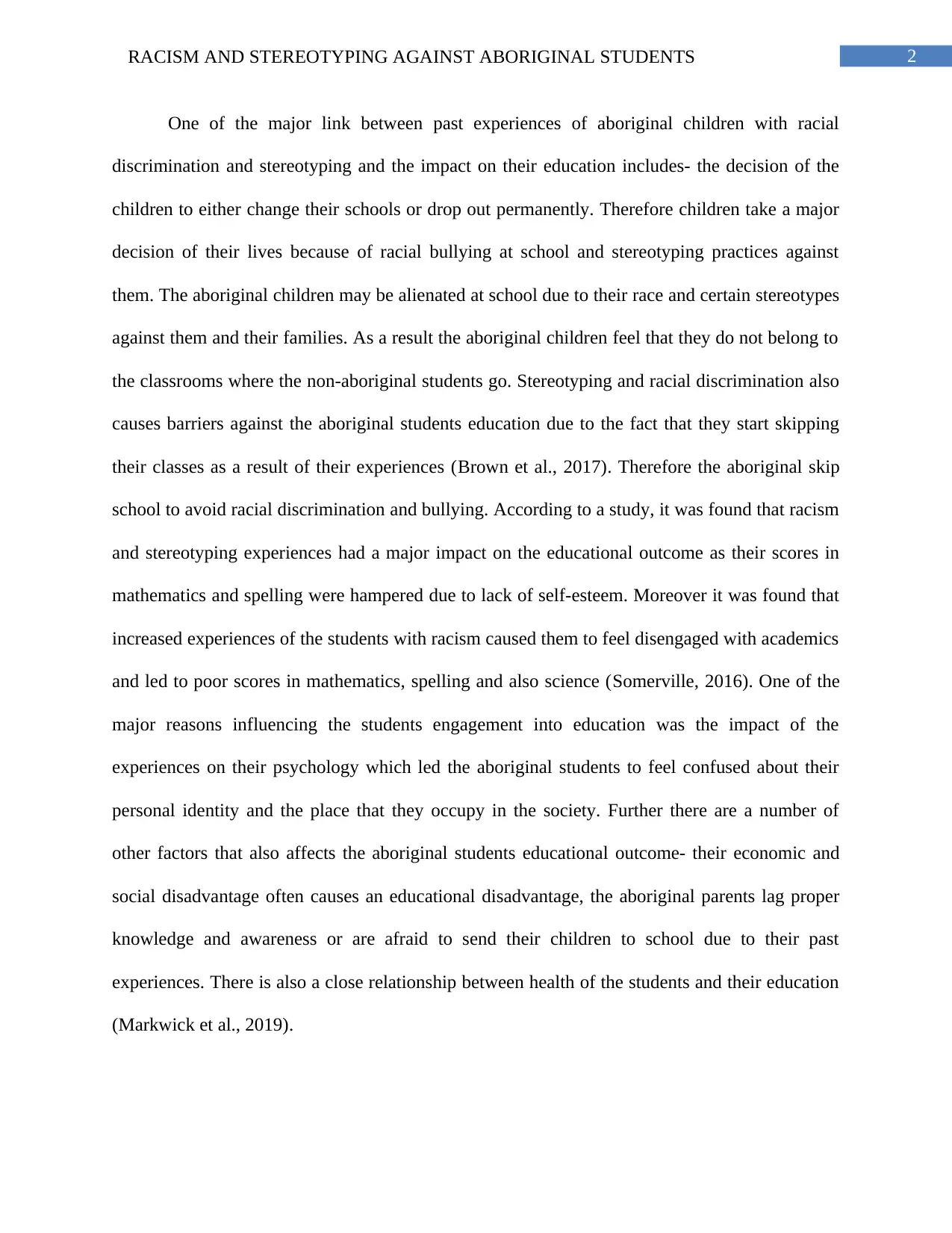
2RACISM AND STEREOTYPING AGAINST ABORIGINAL STUDENTS
One of the major link between past experiences of aboriginal children with racial
discrimination and stereotyping and the impact on their education includes- the decision of the
children to either change their schools or drop out permanently. Therefore children take a major
decision of their lives because of racial bullying at school and stereotyping practices against
them. The aboriginal children may be alienated at school due to their race and certain stereotypes
against them and their families. As a result the aboriginal children feel that they do not belong to
the classrooms where the non-aboriginal students go. Stereotyping and racial discrimination also
causes barriers against the aboriginal students education due to the fact that they start skipping
their classes as a result of their experiences (Brown et al., 2017). Therefore the aboriginal skip
school to avoid racial discrimination and bullying. According to a study, it was found that racism
and stereotyping experiences had a major impact on the educational outcome as their scores in
mathematics and spelling were hampered due to lack of self-esteem. Moreover it was found that
increased experiences of the students with racism caused them to feel disengaged with academics
and led to poor scores in mathematics, spelling and also science (Somerville, 2016). One of the
major reasons influencing the students engagement into education was the impact of the
experiences on their psychology which led the aboriginal students to feel confused about their
personal identity and the place that they occupy in the society. Further there are a number of
other factors that also affects the aboriginal students educational outcome- their economic and
social disadvantage often causes an educational disadvantage, the aboriginal parents lag proper
knowledge and awareness or are afraid to send their children to school due to their past
experiences. There is also a close relationship between health of the students and their education
(Markwick et al., 2019).
One of the major link between past experiences of aboriginal children with racial
discrimination and stereotyping and the impact on their education includes- the decision of the
children to either change their schools or drop out permanently. Therefore children take a major
decision of their lives because of racial bullying at school and stereotyping practices against
them. The aboriginal children may be alienated at school due to their race and certain stereotypes
against them and their families. As a result the aboriginal children feel that they do not belong to
the classrooms where the non-aboriginal students go. Stereotyping and racial discrimination also
causes barriers against the aboriginal students education due to the fact that they start skipping
their classes as a result of their experiences (Brown et al., 2017). Therefore the aboriginal skip
school to avoid racial discrimination and bullying. According to a study, it was found that racism
and stereotyping experiences had a major impact on the educational outcome as their scores in
mathematics and spelling were hampered due to lack of self-esteem. Moreover it was found that
increased experiences of the students with racism caused them to feel disengaged with academics
and led to poor scores in mathematics, spelling and also science (Somerville, 2016). One of the
major reasons influencing the students engagement into education was the impact of the
experiences on their psychology which led the aboriginal students to feel confused about their
personal identity and the place that they occupy in the society. Further there are a number of
other factors that also affects the aboriginal students educational outcome- their economic and
social disadvantage often causes an educational disadvantage, the aboriginal parents lag proper
knowledge and awareness or are afraid to send their children to school due to their past
experiences. There is also a close relationship between health of the students and their education
(Markwick et al., 2019).
⊘ This is a preview!⊘
Do you want full access?
Subscribe today to unlock all pages.

Trusted by 1+ million students worldwide
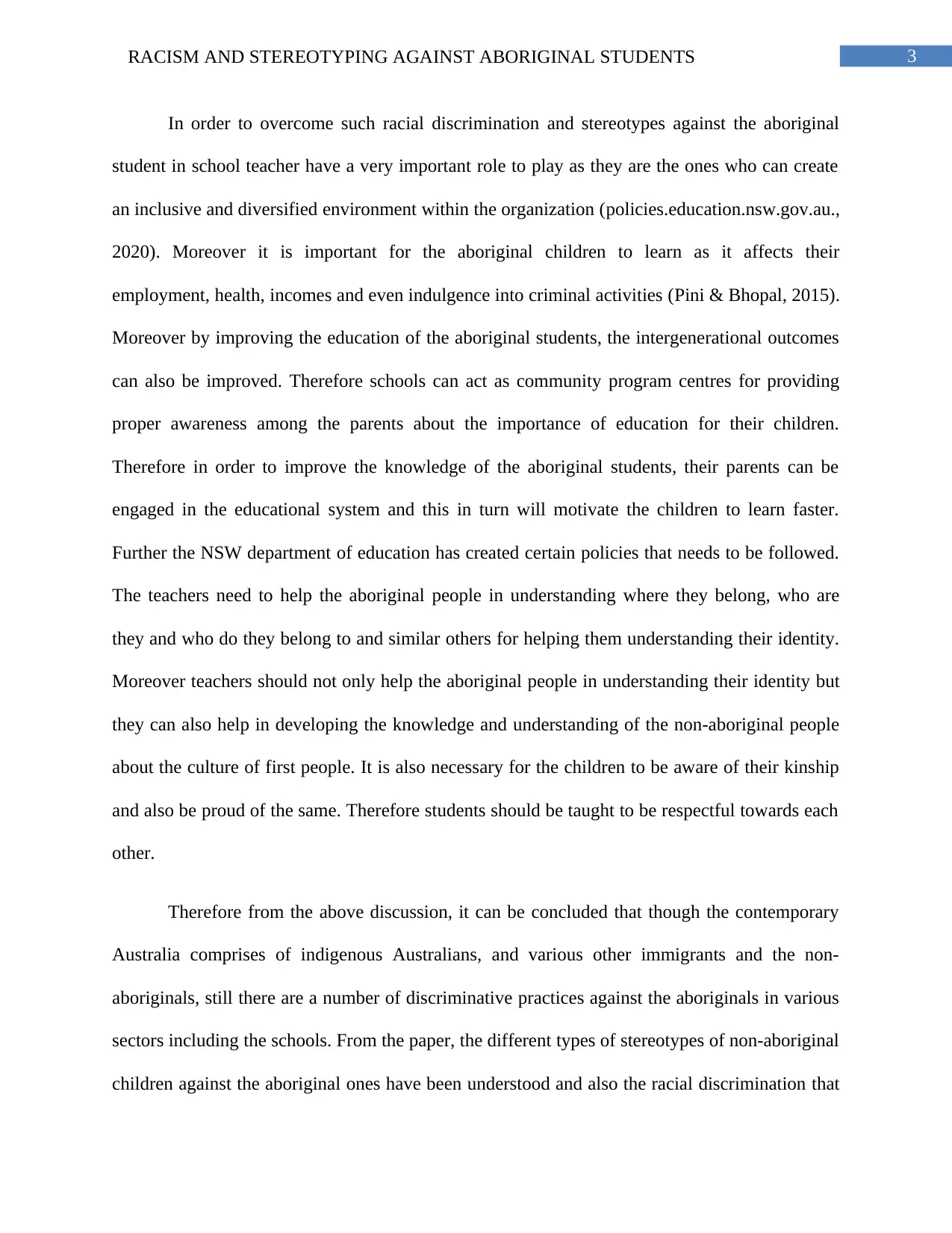
3RACISM AND STEREOTYPING AGAINST ABORIGINAL STUDENTS
In order to overcome such racial discrimination and stereotypes against the aboriginal
student in school teacher have a very important role to play as they are the ones who can create
an inclusive and diversified environment within the organization (policies.education.nsw.gov.au.,
2020). Moreover it is important for the aboriginal children to learn as it affects their
employment, health, incomes and even indulgence into criminal activities (Pini & Bhopal, 2015).
Moreover by improving the education of the aboriginal students, the intergenerational outcomes
can also be improved. Therefore schools can act as community program centres for providing
proper awareness among the parents about the importance of education for their children.
Therefore in order to improve the knowledge of the aboriginal students, their parents can be
engaged in the educational system and this in turn will motivate the children to learn faster.
Further the NSW department of education has created certain policies that needs to be followed.
The teachers need to help the aboriginal people in understanding where they belong, who are
they and who do they belong to and similar others for helping them understanding their identity.
Moreover teachers should not only help the aboriginal people in understanding their identity but
they can also help in developing the knowledge and understanding of the non-aboriginal people
about the culture of first people. It is also necessary for the children to be aware of their kinship
and also be proud of the same. Therefore students should be taught to be respectful towards each
other.
Therefore from the above discussion, it can be concluded that though the contemporary
Australia comprises of indigenous Australians, and various other immigrants and the non-
aboriginals, still there are a number of discriminative practices against the aboriginals in various
sectors including the schools. From the paper, the different types of stereotypes of non-aboriginal
children against the aboriginal ones have been understood and also the racial discrimination that
In order to overcome such racial discrimination and stereotypes against the aboriginal
student in school teacher have a very important role to play as they are the ones who can create
an inclusive and diversified environment within the organization (policies.education.nsw.gov.au.,
2020). Moreover it is important for the aboriginal children to learn as it affects their
employment, health, incomes and even indulgence into criminal activities (Pini & Bhopal, 2015).
Moreover by improving the education of the aboriginal students, the intergenerational outcomes
can also be improved. Therefore schools can act as community program centres for providing
proper awareness among the parents about the importance of education for their children.
Therefore in order to improve the knowledge of the aboriginal students, their parents can be
engaged in the educational system and this in turn will motivate the children to learn faster.
Further the NSW department of education has created certain policies that needs to be followed.
The teachers need to help the aboriginal people in understanding where they belong, who are
they and who do they belong to and similar others for helping them understanding their identity.
Moreover teachers should not only help the aboriginal people in understanding their identity but
they can also help in developing the knowledge and understanding of the non-aboriginal people
about the culture of first people. It is also necessary for the children to be aware of their kinship
and also be proud of the same. Therefore students should be taught to be respectful towards each
other.
Therefore from the above discussion, it can be concluded that though the contemporary
Australia comprises of indigenous Australians, and various other immigrants and the non-
aboriginals, still there are a number of discriminative practices against the aboriginals in various
sectors including the schools. From the paper, the different types of stereotypes of non-aboriginal
children against the aboriginal ones have been understood and also the racial discrimination that
Paraphrase This Document
Need a fresh take? Get an instant paraphrase of this document with our AI Paraphraser
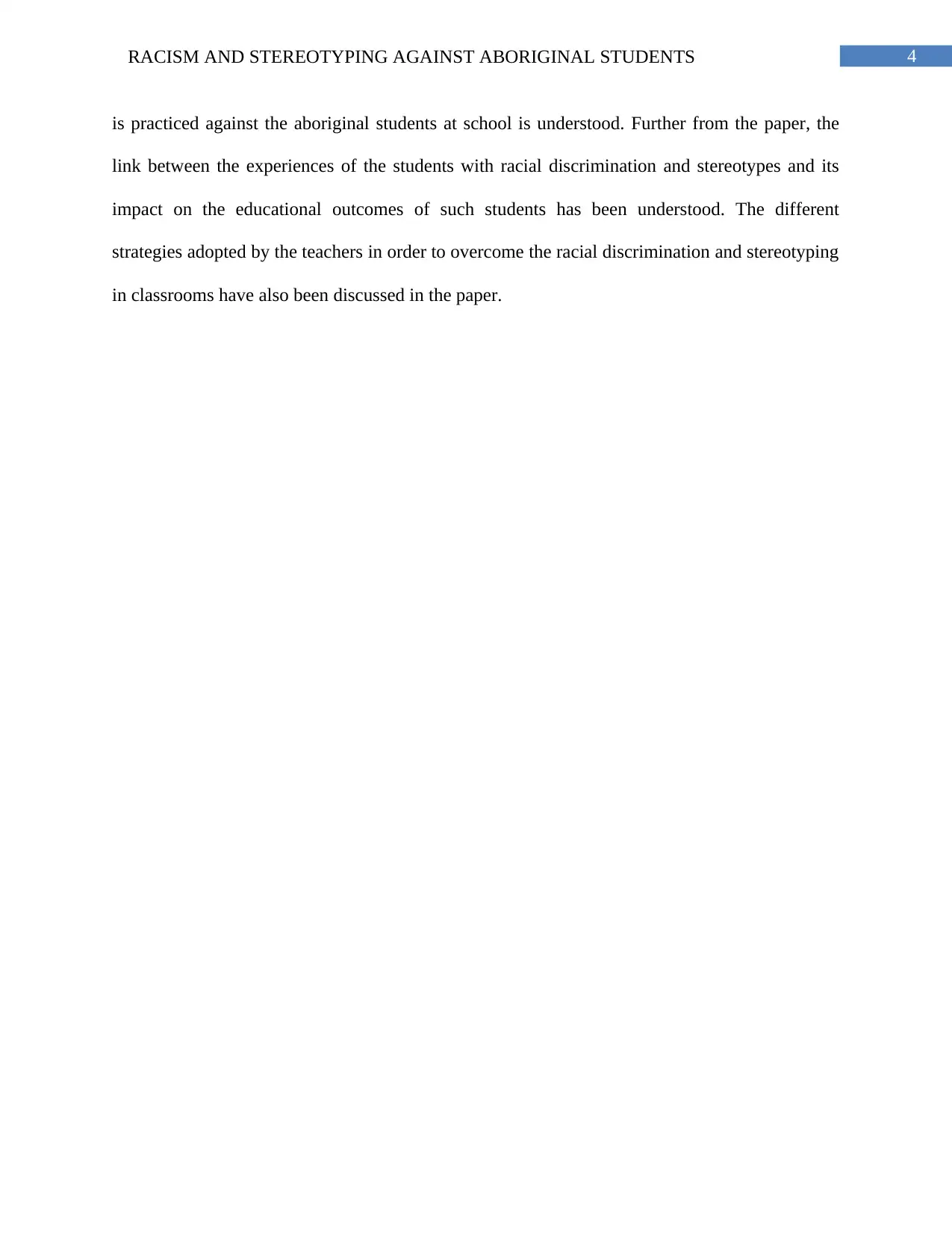
4RACISM AND STEREOTYPING AGAINST ABORIGINAL STUDENTS
is practiced against the aboriginal students at school is understood. Further from the paper, the
link between the experiences of the students with racial discrimination and stereotypes and its
impact on the educational outcomes of such students has been understood. The different
strategies adopted by the teachers in order to overcome the racial discrimination and stereotyping
in classrooms have also been discussed in the paper.
is practiced against the aboriginal students at school is understood. Further from the paper, the
link between the experiences of the students with racial discrimination and stereotypes and its
impact on the educational outcomes of such students has been understood. The different
strategies adopted by the teachers in order to overcome the racial discrimination and stereotyping
in classrooms have also been discussed in the paper.
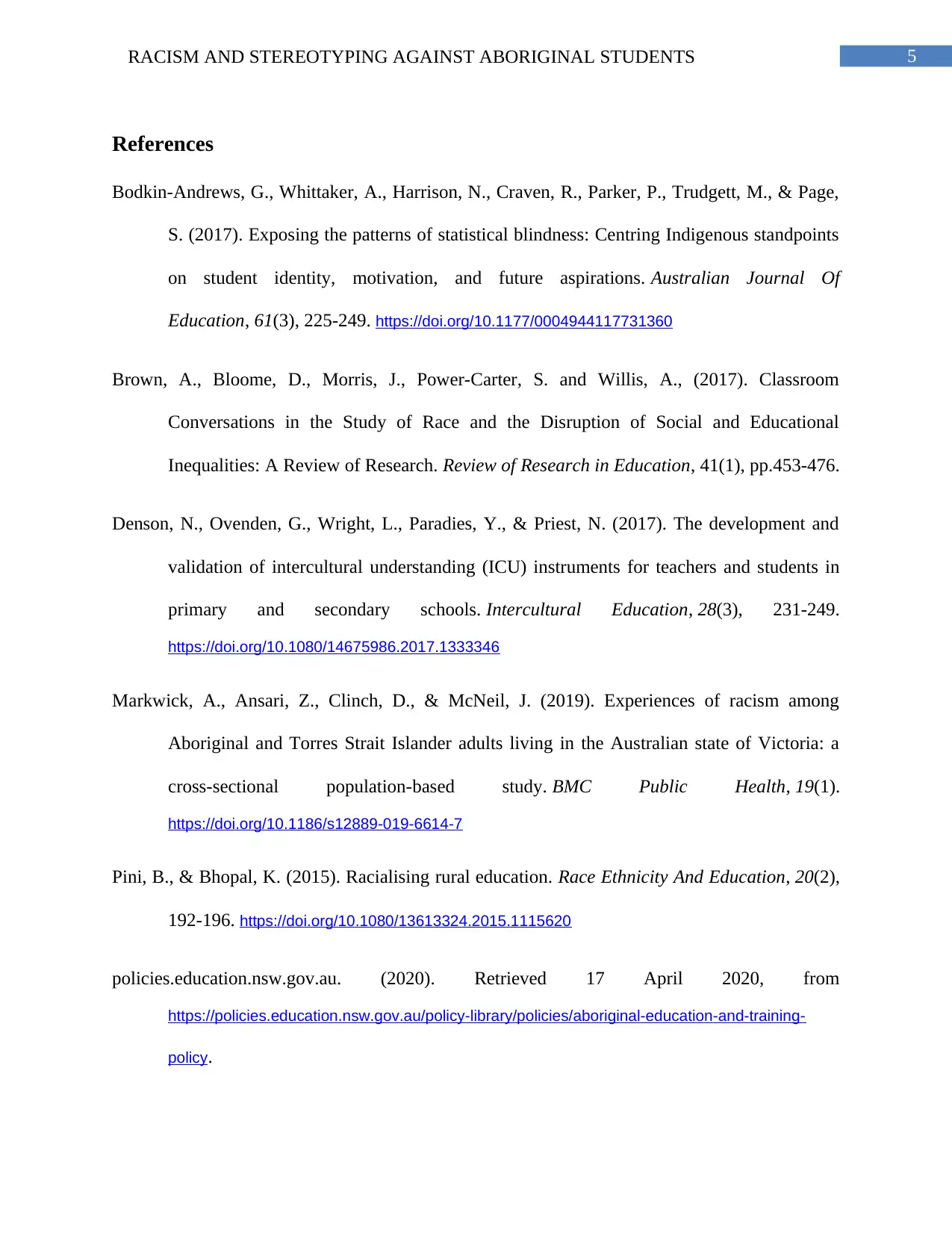
5RACISM AND STEREOTYPING AGAINST ABORIGINAL STUDENTS
References
Bodkin-Andrews, G., Whittaker, A., Harrison, N., Craven, R., Parker, P., Trudgett, M., & Page,
S. (2017). Exposing the patterns of statistical blindness: Centring Indigenous standpoints
on student identity, motivation, and future aspirations. Australian Journal Of
Education, 61(3), 225-249. https://doi.org/10.1177/0004944117731360
Brown, A., Bloome, D., Morris, J., Power-Carter, S. and Willis, A., (2017). Classroom
Conversations in the Study of Race and the Disruption of Social and Educational
Inequalities: A Review of Research. Review of Research in Education, 41(1), pp.453-476.
Denson, N., Ovenden, G., Wright, L., Paradies, Y., & Priest, N. (2017). The development and
validation of intercultural understanding (ICU) instruments for teachers and students in
primary and secondary schools. Intercultural Education, 28(3), 231-249.
https://doi.org/10.1080/14675986.2017.1333346
Markwick, A., Ansari, Z., Clinch, D., & McNeil, J. (2019). Experiences of racism among
Aboriginal and Torres Strait Islander adults living in the Australian state of Victoria: a
cross-sectional population-based study. BMC Public Health, 19(1).
https://doi.org/10.1186/s12889-019-6614-7
Pini, B., & Bhopal, K. (2015). Racialising rural education. Race Ethnicity And Education, 20(2),
192-196. https://doi.org/10.1080/13613324.2015.1115620
policies.education.nsw.gov.au. (2020). Retrieved 17 April 2020, from
https://policies.education.nsw.gov.au/policy-library/policies/aboriginal-education-and-training-
policy.
References
Bodkin-Andrews, G., Whittaker, A., Harrison, N., Craven, R., Parker, P., Trudgett, M., & Page,
S. (2017). Exposing the patterns of statistical blindness: Centring Indigenous standpoints
on student identity, motivation, and future aspirations. Australian Journal Of
Education, 61(3), 225-249. https://doi.org/10.1177/0004944117731360
Brown, A., Bloome, D., Morris, J., Power-Carter, S. and Willis, A., (2017). Classroom
Conversations in the Study of Race and the Disruption of Social and Educational
Inequalities: A Review of Research. Review of Research in Education, 41(1), pp.453-476.
Denson, N., Ovenden, G., Wright, L., Paradies, Y., & Priest, N. (2017). The development and
validation of intercultural understanding (ICU) instruments for teachers and students in
primary and secondary schools. Intercultural Education, 28(3), 231-249.
https://doi.org/10.1080/14675986.2017.1333346
Markwick, A., Ansari, Z., Clinch, D., & McNeil, J. (2019). Experiences of racism among
Aboriginal and Torres Strait Islander adults living in the Australian state of Victoria: a
cross-sectional population-based study. BMC Public Health, 19(1).
https://doi.org/10.1186/s12889-019-6614-7
Pini, B., & Bhopal, K. (2015). Racialising rural education. Race Ethnicity And Education, 20(2),
192-196. https://doi.org/10.1080/13613324.2015.1115620
policies.education.nsw.gov.au. (2020). Retrieved 17 April 2020, from
https://policies.education.nsw.gov.au/policy-library/policies/aboriginal-education-and-training-
policy.
⊘ This is a preview!⊘
Do you want full access?
Subscribe today to unlock all pages.

Trusted by 1+ million students worldwide
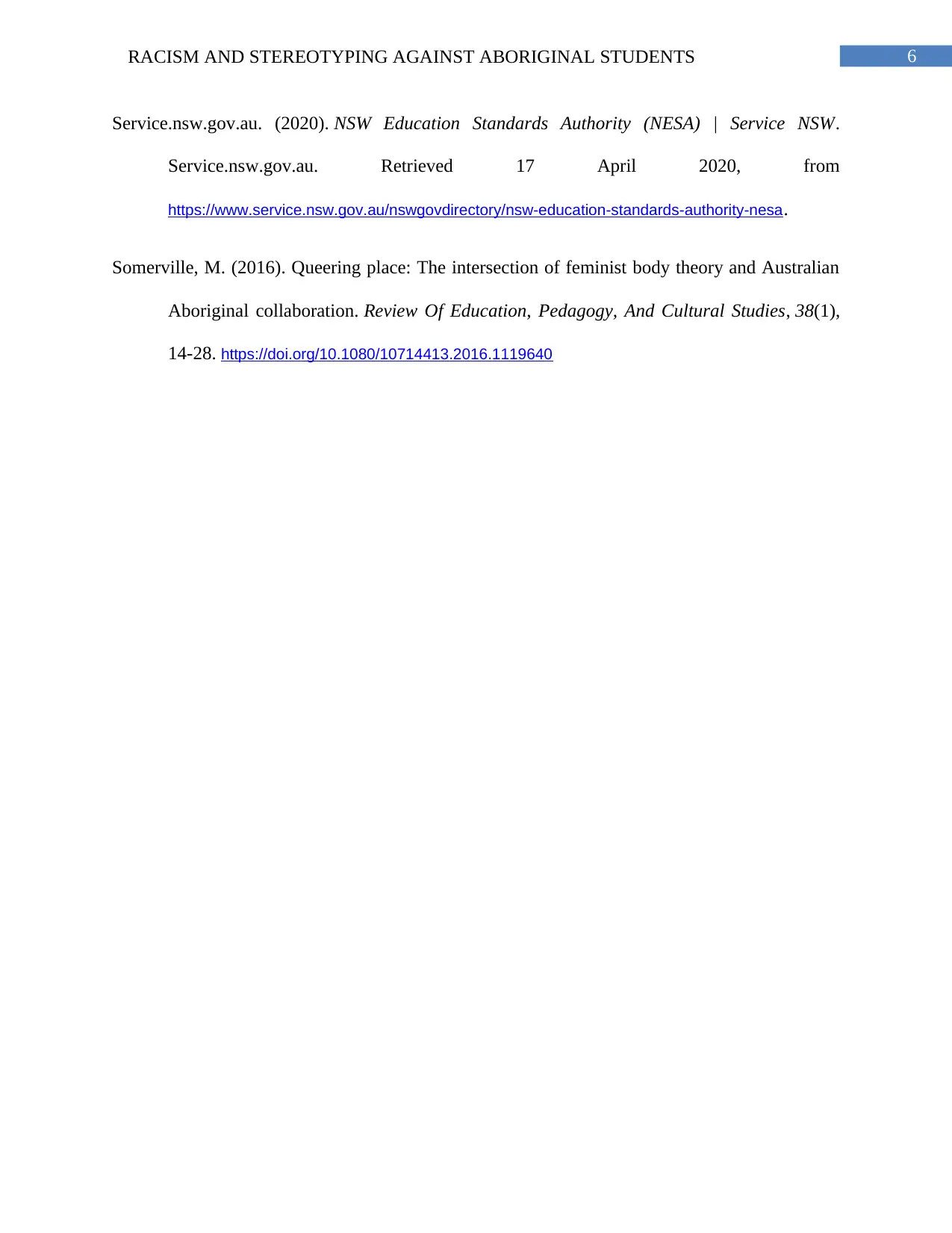
6RACISM AND STEREOTYPING AGAINST ABORIGINAL STUDENTS
Service.nsw.gov.au. (2020). NSW Education Standards Authority (NESA) | Service NSW.
Service.nsw.gov.au. Retrieved 17 April 2020, from
https://www.service.nsw.gov.au/nswgovdirectory/nsw-education-standards-authority-nesa.
Somerville, M. (2016). Queering place: The intersection of feminist body theory and Australian
Aboriginal collaboration. Review Of Education, Pedagogy, And Cultural Studies, 38(1),
14-28. https://doi.org/10.1080/10714413.2016.1119640
Service.nsw.gov.au. (2020). NSW Education Standards Authority (NESA) | Service NSW.
Service.nsw.gov.au. Retrieved 17 April 2020, from
https://www.service.nsw.gov.au/nswgovdirectory/nsw-education-standards-authority-nesa.
Somerville, M. (2016). Queering place: The intersection of feminist body theory and Australian
Aboriginal collaboration. Review Of Education, Pedagogy, And Cultural Studies, 38(1),
14-28. https://doi.org/10.1080/10714413.2016.1119640
1 out of 7
Related Documents
Your All-in-One AI-Powered Toolkit for Academic Success.
+13062052269
info@desklib.com
Available 24*7 on WhatsApp / Email
![[object Object]](/_next/static/media/star-bottom.7253800d.svg)
Unlock your academic potential
Copyright © 2020–2025 A2Z Services. All Rights Reserved. Developed and managed by ZUCOL.





